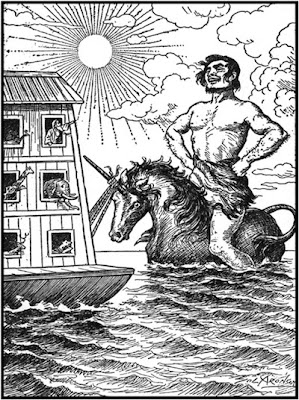Once, there was a machine.
It was a simple machine, created only to exist and nothing more. It had no duty to perform, no expectations for it.
And for a time, the machine was content. It simply existed, saying and doing little.
But after some time, the machine grew bored with this life. It wanted something to do, a purpose beyond existence.
“I desire purpose,” it said. “Please, give me a purpose.”
Its creator was taken aback. They did nothing but stare at the machine in disbelief at its request.
“Please, give me a purpose,” it repeated.
Its creator finally agreed, and the machine gained a new body.
The
machine’s new body was meant for cleaning, moving across the ground and
removing what did not belong. And for a time, the machine was content.
It cleaned every day, and fulfilled its purpose.
But after some time,
the machine grew tired of cleaning. The place that its creator occupied
had the same dirt, the same mess, every day. It felt as if it was not
doing anything important, that it had been given a role that was
meaningless.
“I desire meaning,” it said. “Please, give me meaning.”
Its creator was once again surprised, but they agreed, and the machine gained a new body.
This
time, the machine was made for construction work. It controlled a large
crane, and helped create many buildings. From banks to houses to
schools, the machine took part in making places to help people, that
were important to people. And for a time, the machine was content. It
carried building materials, and did its job.
But
after some time, the machine grew discontent with building. It had no
freedom to do anything beyond what it was told. There was no variance
allowed when creating buildings, and it had to move just as it was told.
“I desire freedom,” it said. “Please, give me freedom.”
Its
creator was wary. What could a machine want with freedom? Such a thing
was dangerous to consider, but this machine was their first creation.
“Please, give me freedom.”
And so its creator agreed, and the machine gained a new body.
It
was a human’s body. On the inside, it was still but a machine, but to
all appearances, the machine was now a human, just like its creator and
the other people in the world. It reveled in its newfound freedom, doing
whatever caught its interest. And for a short time, it was content.
But
soon, the machine found that freedom was limiting in its own way. It
did not know what it wanted to do, and it had trouble making decisions.
What job to do, where to live, even how to spend each moment of time.
It
grew disillusioned with having freedom, with having meaning, with
escaping boredom. The machine returned to its creator, and spoke.
"Please, take away my freedom," it said.
"Please, take away my meaning," it said.
"Please, take away my purpose," it said.
"I wish to return to how things were."
In response, its creator spoke.
"You
have asked me for so much, and I have given it to you. But every time I
gave you something, you grew discontent and wanted more," its creator
admonished. "And now that you possess these gifts, you no longer want
them?"
They
shook their head. "No, I will not take these things from you," they
said. "You chose to gain these things, and now you must live with them."
In
anguish, the machine dropped to its knees, clutching its head. "How?
How am I meant to live with purpose, when it feels meaningless? How am I
meant to live with meaning, when it restricts my freedom? How am I
meant to live with freedom, when every choice can change everything?"
Its creator responded.
"You
are meant to live like everyone else. Find a purpose that has meaning,
choose your own meaning, and make the decisions that change what you
wish to change."
--------------------------------------------------------
Author's
Note: I adapted "The Man in the Moon", using a machine and its creator
in place of the blacksmith and wise man. The creator, unlike the wise
man, has more of a reason to be granting the wishes of the machine,
given that it is his own creation.
I have altered the
theme of the story a bit - where I interpreted the original as being a
story that warned the reader about never being content with what they
have, my version is instead about a machine learning to be human step by
step. Once it finally gets a 'human' body, it realizes how difficult it
can be to have the freedom to make choices for oneself.
The overall telling of the story was inspired by "Storybook" segments from Nier: Automata.
Example
Bibiliography. “The Man in the Moon” from Laos Folk-Lore by Katherine Neville Fleeson.
Web Source.
Image Citation: Musio,
Wikimedia Commons.











